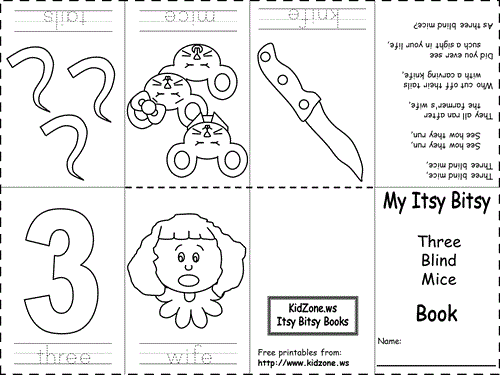DLTK's Nursery Rhymes for Kids
Three Blind Mice
Three blind mice, three blind mice,
See how they run,
See how they run,
They all ran after the farmer's wife,
Who cut off their tails with a carving knife,
Did you ever see such a sight in your life,
As three blind mice?
Three Blind Mice Coloring Pages and Lyrics:
Three Blind Mice Crafts:
Three Blind Mice Vocabulary Word Printables:
Three Blind Mice Printable Resources:
Three Blind Mice Puzzle Worksheets:
On-Line Games and Puzzles:
The History of "Three Blind Mice"
"Three Blind Mice" is one of the oldest and most well-known nursery rhymes, enchanting children with its simple yet catchy tune and rhythmic lyrics. The rhyme tells the story of three visually impaired mice who chase after a farmer's wife, only to have their tails cut off. Despite its seemingly grim narrative, the rhyme has remained a favorite among children for its repetitive and easy-to-sing structure.
Origins and Early Versions
The earliest known publication of "Three Blind Mice" dates back to 1609 in "Deuteromelia," a book compiled by Thomas Ravenscroft. The original version of the rhyme was set to music and included in this early collection of folk songs. Over time, the rhyme has evolved into the version familiar to us today.
Interpretations and Theories
Some historians believe that the rhyme might have political undertones. One interpretation suggests that it references the persecution of Protestant loyalists by Queen Mary I of England, also known as "Bloody Mary." According to this theory, the "farmer's wife" is Mary I, and the three blind mice are noblemen who were convicted of plotting against her. However, this interpretation is debated, and the rhyme is more commonly viewed as a simple children's song with no political significance.
Cultural Impact and Adaptations
Throughout its long history, "Three Blind Mice" has been adapted and referenced in various forms of media, including literature, music, and film. Its enduring popularity is due in part to its memorable melody and the playful imagery of the three mice. Despite the dark undertones, the rhyme has often been presented in a light-hearted and entertaining manner, making it suitable for children.
Educational Uses
The simplicity and repetition of "Three Blind Mice" not only make it easy to learn but also help children develop language and memory skills. The rhyme continues to be a staple in nurseries and classrooms around the world, a testament to its lasting charm and appeal.












